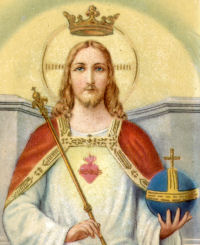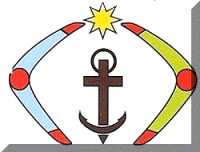
Collect Prayer
Almighty ever-living God, whose will is to restore all things in your beloved Son, the King of the universe, grant, we pray, that the whole creation, set free from slavery, may render your majesty service and ceaselessly proclaim your praise. Through our Lord Jesus Christ, your Son, who lives and reigns with you in the unity of the Holy Spirit, God, for ever and ever.
Ordinary Time: November 21st
Solemnity of Our Lord Jesus Christ, King of the Universe
Pope Pius XI instituted the Feast of Christ the King in 1925 as an alternative against secularism, a way of life that excludes God from man’s thinking and existence and organizes his life as if God did not exist. The purpose of the feast is to declare Christ’s majesty over individuals, families, society, governments, and nations in a bold and powerful way.
The titles for Christ’s kingship over men are established in today’s Mass: 1) Christ is God, the Creator of the universe, and thus has supreme power over all things; “All things were created by Him”; 2) Christ is our Redeemer, He purchased us with His precious Blood, and made us His property and possession; 3) Christ is the Head of the Church, “holding all things in primacy”; 4) God bestowed the nations of the world to Christ as His exclusive possession and dominion. The characteristics of Christ’s kingdom are also described in today’s Mass. This kingdom is: 1) supreme, extending not only to all people but also to their princes and kings; 2) universal, extending to all nations and al places; 3) eternal, because “The Lord shall sit a King forever”; and 4) spiritual, for Christ’s “kingdom is not of this world.” — Msgr. Rudolph G. Bandas, Rt. Rev.
In the previous (1962) calendar, this feast was observed on the last Sunday of October.
The Sunday liturgy supersedes the Memorial of the Presentation of Mary, which is normally celebrated today.
The Liturgy’s Representation of Christ the King
The liturgy is a photo album in which every epoch of Church history is immortalized. As a result, the different depictions of Christ that have become popular over the years can be found there. In its pages, we find images of Jesus in pain and suffering; we see images of His Sacred Heart; nonetheless, these images are not proper to the nature of the liturgy as a whole; they resemble baroque altars in a Gothic church. Classical liturgy recognizes only one Christ: the brilliant, magnificent, and heavenly King.
All Advent awaits the “coming King” with greater and greater desire; in the breviary chants, the two expressions “King” and “is coming” are repeated over and over. The Church would greet, not the Child of Bethlehem, but the Rex Pacificus — “the King of peace gloriously ruling” — on Christmas. Within a fortnight, there will be a feast that ranks among the most important of the Church year’s feasts: the Epiphany. As in ancient times, when oriental kings visited their realms (theophany), the heavenly King appears in His city, the Church; He casts His gaze across the entire planet from its holy precincts…. On the concluding feast of the Christmas cycle, the Presentation in the Temple, holy Church receives her royal Bridegroom with virginal love: “Adorn your bridal chamber, O Sion, and accept Christ your King!” The weight of the Christmas season might be summed up in these words: Christ the King establishes His Kingdom of light on earth!
When we consider the Easter cycle, the luster of Christ’s royal dignity is somewhat veiled by His sufferings; however, it is not the suffering Jesus who is present in the eyes of the Church as much as Christ the royal Hero and Warrior who struggles with the mighty and dies in triumph on the battlefield of Golgotha. The Church praises her King even during Lent and Passiontide. On Palm Sunday, we chant psalms in festal procession, accompanying our Savior, singing: Gloria, laus et honor tibi sit, Rex Christe, “Glory, praise, and honor be to Thee, Christ, O King!” On Good Friday, the Church contemplates the Man of Sorrows in agony on the Cross, but at the same time, and perhaps more so, she sees Him as King upon a royal throne. The hymn Vexilla Regis, “The royal banners forwards go,” is a more appropriate depiction of the attitude from which the Good Friday ritual sprang. Also notable is the Psalm 95 phrase, Dicite in gentibus quia Dominus regnavit, to which the early Christians invariably added, a ligno, “Proclaim among the Gentiles that the Lord reigns from the tree!” During the Paschal season, the Church is so occupied with her glorified Savior and Conqueror that kingship references are rarer; but, near the close of the season, we celebrate our King’s triumph after finishing the work of redemption, His royal enthronement on Ascension Thursday.
Neither in the time after Pentecost is the image of Christ as King completely missing from the liturgy. Corpus Christi is a regal celebration: “Christ the King who reigns the nations, come, let us adore” (Invit.). The feast of the Transfiguration is the main solemnity in the Greek Church to commemorate Christ’s kingdom, Summum Regem gloriae Christum adoremus (Invit.). Finally, at the end of the ecclesiastical year, the Church eagerly awaits the return of the King of Majesty.
We’ll disregard future considerations in favour of a quick check at the daily Offices. How often do we begin Matins with a royal homage: “The King of apostles, martyrs, confessors, and virgins — come, let us worship” (Invit.). Lauds is frequently introduced with Dominus regnavit, which means “The Lord is King.” Christ as King is also a first thought at the start of each day, as we repeat our promise of fidelity at Prime every morning: “To the King of ages be honour and glory.” Every oration is ended by our Mediator, Christ Jesus, “who lives and reigns forever.” Yes, the ancient liturgy depicts Christ reigning as King in His basilica (etymology: “the king’s house”), seated as His throne upon the altar.
—Excerpted from Pius Pasch’s The Church’s Year of Grace
Commentary on the 1962 Roman Missal readings:
Last Sunday following Pentecost “Then the sign of the Son of Man will appear, and He will send forth His angels with a trumpet. They will collect His chosen ones from the four winds ” (Gospel).
The end of the world is near! Such a message would cause “all nations of the world to cry,” particularly him, who clings to earthly things and suddenly understands he must “not turn back to collect his cloak.” Let us be realistic: the world will disintegrate and vanish in ruins!
Today marks the end of the liturgical year. It represents the final ascension of Jesus’ Mystical Body into heaven, the final act of an eternal drama.
May we flee from the “false Christs” who “lead astray…even the elect” (Gospel), enslaving, deceiving, and poisoning their minds through the press, television, and film.
—Extracted from the Confraternity of the Precious Blood’s Sunday Missal
Collect Prayer
Almighty ever-living God, whose will is to restore all things in your beloved Son, the King of the universe, grant, we pray, that the whole creation, set free from slavery, may render your majesty service and ceaselessly proclaim your praise. Through our Lord Jesus Christ, your Son, who lives and reigns with you in the unity of the Holy Spirit, God, for ever and ever.

